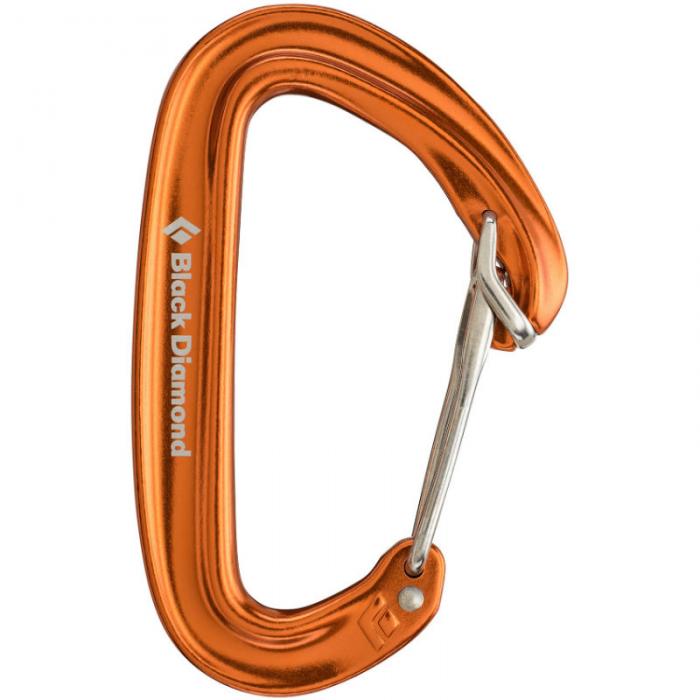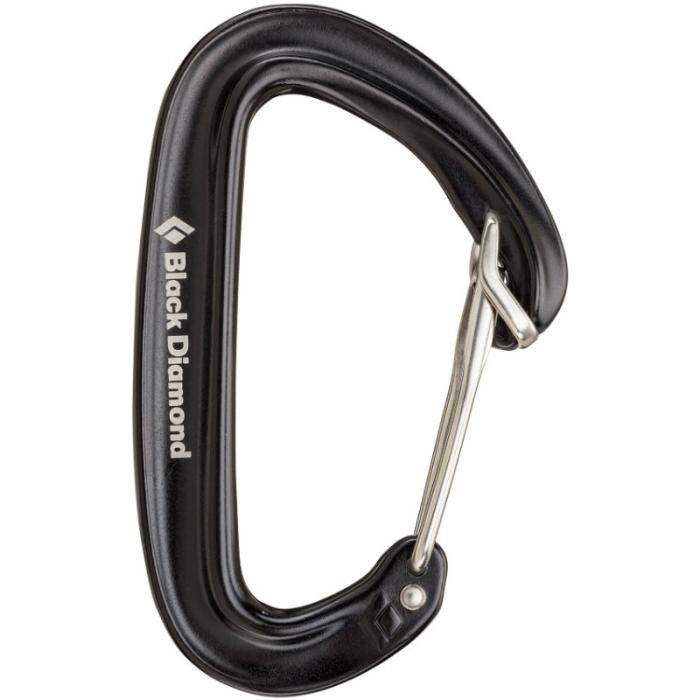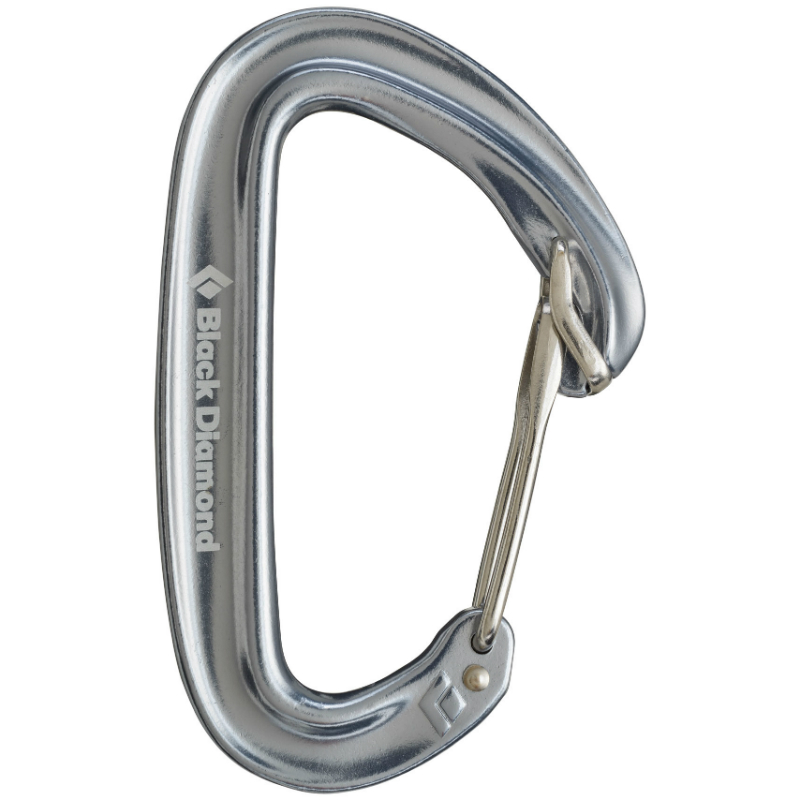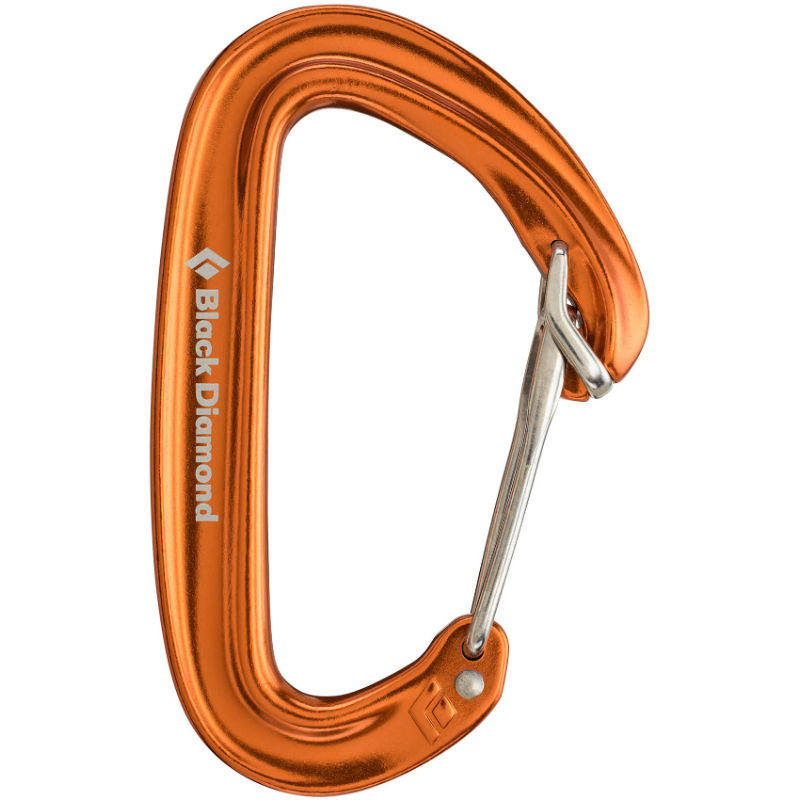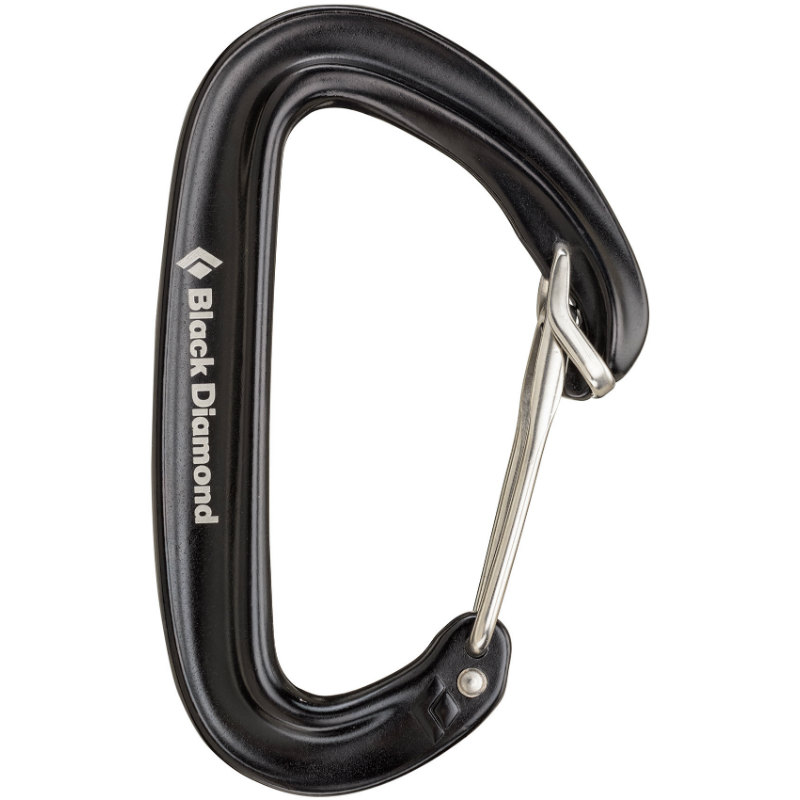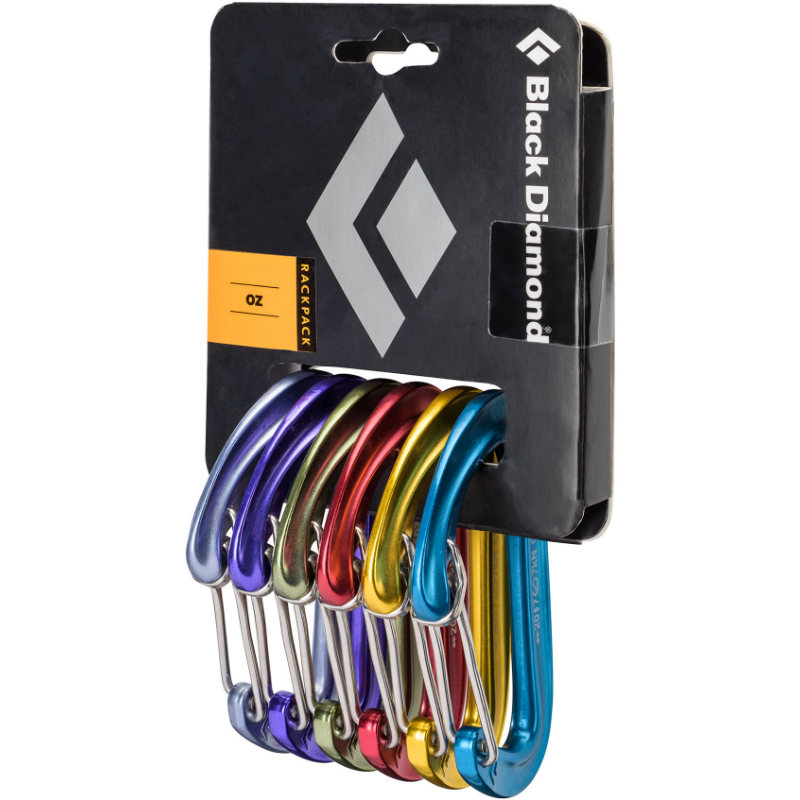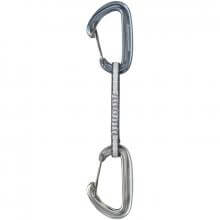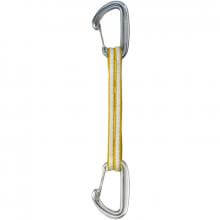Oz
Description
Redesigned with an optimized shape and the snag-free benefits of our HoodWire Technology, the 1-ounce, hot-forged Black Diamond Oz is still the best way to lighten your rack. A patent-pending stainless steel wire hood brings keylock functionality to wiregate carabiners without losing the lightweight and anti-freezing benefits. And thanks to the Oz's new geometry, it holds strong as the lightest carabiner in our line.
Hot-forged construction
Patent-pending stainless steel wire hood design provides snag-free keylock functionality
New optimized shape
Same size and clip-ability as the Neutrino, but 8 grams lighter
Does not freeze up in alpine conditions
Retail price
This Product is Hard to Find.
We don’t know where you can buy this item online in the US. We’ll continue to check all the major retailers and will update this page as soon as we find one.
If you know where to find this online in the US, let us know, and we’ll add the link.


Weight (g)  Weight (g)In grams, the weight, as stated by the manufacturer/brand. |
28 g |
Shape  ShapeRule of thumbAlmost every carabiner you use will be non-locking offset D’s, with the exception of a Pear/HMS locker as your belay ‘biner. Offset D (aka Modified D)60% of the market 
A modification of the standard D shape, the top of an offset D is much wider, allowing for a larger (and superior) gate opening. When loaded, most of the weight is transferred to the spine of the carabiner making them stronger than most other shapes. Used for top and bottom quickdraws, as racking carabiners, and lightweight lockers. Pear / HMS22% of the market 
The Pear/HMS carabiner is used primarily for belaying and/or setting a powerpoint in an anchor. The wide top means they can hold a lot of gear. They are almost always locking and are generally heavier (than D/offset D's) because they need more material to gain back strength lost due to their shape. Oval8% of the market 
The first carabiner shape to be mass produced. When loaded, the pressure is shared equally on both sides of the ‘biner. Since the weaker gate shares the load with the spine, oval biners aren’t as strong as shapes that direct the load to the spine. The bonus is, your gear rests squarely in the middle, so it's great for holding nuts, pulleys, and prusiks. D (aka symmetric D)7% of the market 
D’s have a symmetrical shape that sets the rope closer to the spine, putting the load on the spine (versus sharing the load with the weaker gate side, like the oval). Since the strongest part of the carabiner carries the weight, D’s are the strongest shape. Downside: Smaller gate openings than the offset D. Quick Link (aka Oval link, Maillon Raptide)1% of the market 
Although most climbers wouldn’t refer to this shape as a “carabiner” they are certified by the same EN standard as all the other carabiners. These semi-permanent links ensure the gate will not accidentally open. They're used when setting up a semi-permanent rappel station (not used while climbing up). Semi-Circle / 3Dless than 1% of the market 
Semi-circle: Mostly used by Search and Rescue as this is a great way to secure a chest harness. Learn More
Pros and cons of each shape, graphs and more examples |
D / Offset D |
Locking  Lockingmain non-locking carabiners uses:
main locking carabiners uses:
screw gate vs auto-locking gateScrew gates are generally lighter and cheaper. Auto-locking gates are usually considered safer as they automatically snap shut, not counting on one's memory to close and are harder to accidentally unlock. The debate comes on opening speed as some are much faster while others can be a struggle. Learn More
See the newest auto-locking gate technologies |
No |
Straight or Bent  Straight or BentIt's easier to see the difference between straight and bent gates on solid gate carabiners: 
Straight GateThe standard. Always used as the bolt-end of the quickdraw, and still sometimes used on the rope-side too. Also used for racking gear such as cam and nuts. Bent GateCreated to make it easier to put the rope into a quickdraw with their larger gate opening. Primarily used on the rope-end (bottom) of quickdraws. Extra Notes
Important NoteMany manufacturers are now making the bolt-end carabiner come standard in silver (to match the bolt color), and are coloring the rope-end with other anodizations. Do not mix (interchange) bolt-end carabiners and rope-end carabiners. This can be very dangerous as small abrasions made by the bolt can easily wear your rope. DMM put out a great video/write-up on this issue. |
Straight |
Full Size  Full SizeFull size carabiners are easier to hold but generally they're also heavier. This is a totally debatable field as there is no official size, weight, or gate opening necessary to be full size. There are no certifications and this isn't a standard the manufacturer's normally describe specifically. We did our best to compare (descriptions, in-person use, etc), as a way to help give more information about this carabiner. Like always, if you see something that seems totally off, send us a note. |
No |
Keylock  KeylockA keylock nose means the nose is smooth. Keylock carabiners are also known as: snag-free, notch-less, and hook-less. 
Keylock BenefitThe lack of a hooked nose makes for less snagging on gear and bolts – a dramatic improvement. Keylock DrawbackGiven that they’re more complicated to manufacture, keylock designs often come at a higher price, especially in wiregates. Worth ConsideringThere are more design features necessary to guarantee a snag-free experience, like the curvature of the nose. Some keylock carabiners will still catch on the nose because of the lack of a smooth nose arc (smoother the arc, smoother the clip). Learn More
Check out our blogpost that goes over carabiner nose design to get all the details |
Yes |
Solid or Wire  Solid or Wire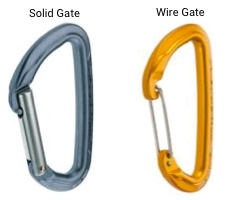
Solid GatesGenerally on beefier carabiners, so they're usually heavier and more durable. They can also feel more substantial in your hands while clipping. Often favored by sport climbers. Wire GatesFeatured on the lightest carabiners, so they're favored by trad and alpine climbers. Some considerationsIf you want keylock nose carabiners, then solid gates will be much cheaper compared to wire gates. When wiregates first came out they were not trusted (too new, looked too simple). Now, it's proven that wiregates have less gate flutter and gate shutter than solid gates. Learn More
Compare gate flutter and gate shutter |
Wire |
Gate Opening  Gate Opening (mm)Gate opening refers to the distance between a carabiner’s nose and the fully open gate. 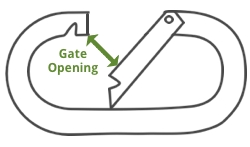
General Guidelinestop of your quickdraw: 17 mm – 22 mm Adding bias towards a larger gate opening is a great option once you’ve narrowed your choice to a few similar carabiners and need help determining which one is the best. Learn More
Gate opening comparisons, examples, averages, shape, sizes, graphs, and explanations |
22 mm |
Number of Colors  Number of ColorsThe number of different colors that you can find this carabiner in. This color-coding practice was started with just 2 colors, usually silver (that goes on the bolt side of a quickdraw) and another color for the rope side. Now, carabiners come in 5+ colors sets known as "rack packs" so your carabiners can match your cams. Climbers can also match their carabiner color to their harness or other gear just for fun. Learn MoreCarabiner Rack Packs Explained |
7 |
Lock Indicator  Visual Warning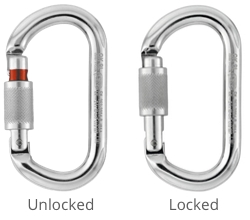
A lock indicator is a visual warning only seen on locking carabiners. It adds some sort of visual to show if the carabiner is unlocked such as the color red, a danger sign, an unlocked image, etc. When the carabiner is locked the visual indicator is hidden. Only a small list of manufacturers add this safety feature, although you can easily add one yourself with a permanent marker. |
No |
Strengths (kN)  Strengths (kN)In kilonewtons, the strength, as stated by the manufacturer/brand. Major Axis Closed Gate Strength
This is the strongest orientation and the way carabiners are designed to be loaded. Major Axis Open Gate Strength
This strength is measured because while climbing, carabiners lying against the rock can be opened slightly as they move across an uneven surface. A carabiner can also open slightly during a fall as the ‘biner starts to vibrate, dispersing the energy (also called "gate flutter"). A weak gate closure (due to a poor/failing spring or an over-stressed wire) could also leave the gate ajar. Minor Axis Gate Strength
Carabiners are not intended to be loaded along the minor axis (cross-loaded), but it is possible for a carabiner to unintentionally rotate during use, especially while belaying. Of all accidental misuses of a carabiner, cross-loading is the most frequent suspect, which is why there is a rating for it. Generally wire gates are stronger than solid gates in the minor axis. During the test, the wire gate bends, absorbing some of the force, as compared to a less pliable solid gate. Learn More
How carabiners are rated, recommendations and strengths. | |
Wizard of OZ
by teebearpicnic on 12/25/2016Sometimes it's easy to get caught up in the goal for lighter and lighter gear, and forget that the gear does not just sit on a scale looking smug but will actually get out onto a climb and need to be functional. The "keychain" carabiners seem like a good party trick ("Yes these really are full-strength…") but when it comes to something you'd actually want to climb with, weight isn't the sole consideration. Black Diamond seems to have found the right mix of weight and usability with the Oz. They made it as light as they could while still keeping this product something you'd actually want to use on your cams and not just your nut tool. If you are looking for a biner that's lightweight and high-performance, our Top Pick award winner is the way to go.
The Oz quickdraws have gotten a lot of use and I am happy to have the variety added by having four longer DMM Phantom draws. I have gotten used to the lightweight feel of the Oz biners and can clip them with ease. Having quickdraws that only weigh around 60 grams each really helps reduce the weight on longer climbs. They also help you have a lighter pack for strenuous Sierra aproaches.
The last new toy that has become part of the rack is the Black Diamond OZ. This biner weights 28g or one ounce. It is the same basic shape as the Neutrino but with less metal. As a result the OZ is not as strong at 20Kn versus 24Kn for the Neutrino. The biner handles well and is noticeably lighter than the Neutrino. Our primary use for the OZ is a racking biner for our cams. They sit well and are ok to clip. This past weekend I doubled them up for use as alpine draws and they helped shave a considerable amout of weight. They are not the lightest on the market, bested by the Camp Nano at 23g, the Mammut Moses at 26g and the Dmm Phantom at 27g, but are still well below the average 40g biner. Overall I enjoy using these biners and time will tell in regards to their durability.
The Oz feels almost like a standard carabiner. Its frame is among the easiest to grab, it holds the most gear and its wire gate has the best action. It also has the widest rope-bearing surface, making it the most rope-friendly of the carabiners, though just barely. I also liked the gently curved lower arm, which will take wide webbing and pins better than the other biners. A few outings with the Oz made me wonder if I’ll ever go back to larger, heavier quickdraws for anything other than big-wall racking.
It would be inappropriate for everyone to replace their 'biners with the Oz, but in the alpine, or other situations where weight is a critical component, the Oz is a pretty hot piece of work. While there are other great lightweight 'biners on the market, the weight and quality of the Oz make it an outstanding piece of gear worthy of the Alpinist Mountain Standards medal.
Pros: Hot-forged construction makes this 'biner extremely strong and lightweight; wiregate allows snow to pass through; gate opening works well, even in high load or high stress situations.
Cons: Harder to clip than a full-size 'biner; easy to fumble with cold hands; nose can snag.
No voice but worth watching.
Video shows how the Black Diamond carabiners are made.



